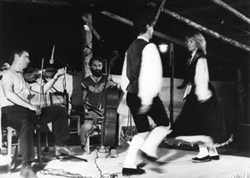|
Citira: the fiddle in Resia
Valley
by Giulio Venier

In the Resia
Valley (north-east of the Friuli region)
lives one of the most interesting ethnic minorities of Italy. Thanks
both to its geographical remoteness and its social cohesion it
maintains very particular cultural features in language (a particular
dialect of slavish origin), music, dance and customs.
Here the music is only performed by two instruments: Citira (fiddle) and Bunkula (three-stringed cello).
This repertoire is well alive and also flourishing because, besides the
old tunes, the best players compose some new ones which are often named
after them. In this way some fiddlers have tied their name to the local
musical history.
All the tunes have a two-part structure:
the first one
fingered in the Key of D (called na
tenko) and the second one in the key of G (called na tusto) fingered in the same way
a fifth lower.
The melodies are so repeated for several times. In the first part the
cello rhythmic drone is a double sound D-A while in the second one it
is a simple G, so that strings are never fingered at all. Another
essential element of the tune is the hard foot stamping of the fiddlers
who play sitting down.
It’s custom to
tune
the fiddle at least a whole tone higher or more, to get a
louder sound in the open. Tunes are played in the common D and G
fingering but
the real keys often sound higher, up to F and Bb.
Another feature is that the
fiddler, after playing the D note, often remains with his 3rd
finger
on that string, so to produce with the adjacent open E string the
typical
dissonance of the local vocal style.
Still nowadays the fiddle music sounds in every
social
gathering of the Resian community: Assumption, carnival, wedding
parties and conscription.
|
Associazione
Violinistica Italiana
postmaster@italianfiddle.com
index
|
 www.italianfiddle.com
www.italianfiddle.com